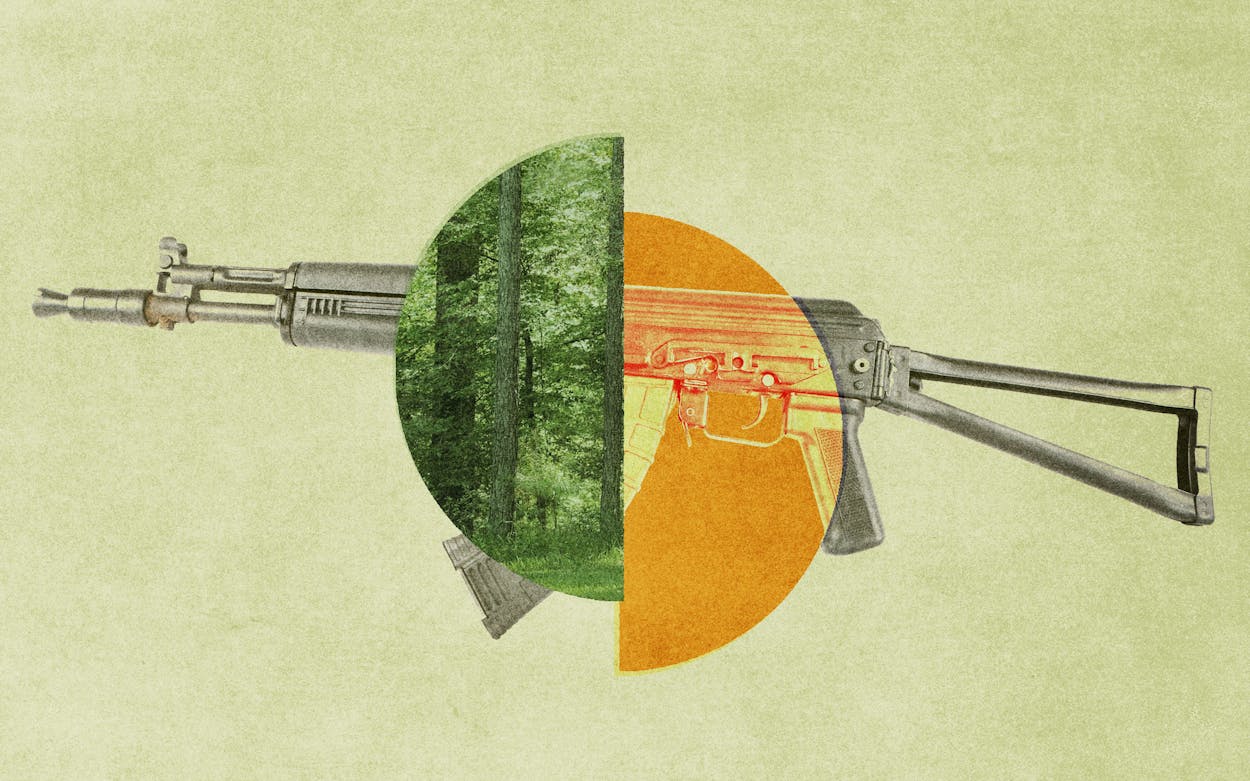Two neighbors were walking their dogs in Austin’s Little Stacy Neighborhood Park in late May when they came upon a man behaving strangely. It wasn’t the first time Chelsey and Scott, both of whom asked that we withhold their last names for their safety, had noticed the man. Chelsey regularly went on morning runs and had seen him lurking alone enough times that she decided to change her jogging route. On walks with his dog, Scott would see the man chain-smoking and walking in tight circles near his car, a red BMW. Scott had alerted some of his neighbors with young children, as well as some of the women he knew. “There’s a creeper hanging out in the park,” he told them. “Be careful.”
On this particular occasion, Scott, who was walking ahead of Chelsey, caught sight of the man first, as he sat on a park bench at the top of a hill. Scott noticed something resting across the man’s lap that he suspected might be a gun. By the time Chelsey caught up with Scott, the man had moved to a picnic table, upon which a long, flat case rested, with “Mossberg” written across it. Scott searched the word “Mossberg” on his phone and discovered it was the name of a prominent firearms manufacturer.
Moments later, they heard the sound of a gun pumping and looked up to find the man standing atop a hill, some thirty yards from where they stood, brandishing a shotgun. Other parkgoers approached, unaware, with strollers. “My original thought was, ‘This is what it feels like to be in a mass shooting,’ ” Scott said. “It’s terrifying once the thought enters your mind, and seeing all the strollers with little babies coming right towards him.” His other thought was: Run.
He and Chelsey fled the park and tried to alert parkgoers who were coming in their direction. Once they’d evacuated, Scott called the police. Then he took his dog home. Fifteen minutes later, Scott got in his car and drove back to the park to investigate. Two policemen were talking to the man, now standing near his car. Assuming the police had the situation under control, Scott drove off.
According to Austin Police Department records that Texas Monthly obtained through a public records request, the man, identified as Yevgen Buchkovskiy, told a responding officer that he was visiting from Houston and that he had previously lived in a house near the park. Buchkovskiy, who was later identified as a 44-year-old gymnastics coach, spoke with a strong accent. He told the officer he was from Russia, though his ID showed he was from Ukraine. (Multiple attempts by Texas Monthly to reach Buchkovskiy at his place of work and through his family on social media were unsuccessful.)
One of the responding officers asked Buchkovskiy to show him the shotgun, which was in his trunk. Buchkovskiy did so, and one officer recorded in his report that the gymnast said he had purchased it under a different name, Aston Dolton, “which I thought was very strange.” Then police released Buchkovskiy, free of charges. “Yengen’s [sic] story seemed odd but I was not sure if it was a language barrier,” the report stated. “We explained to him he could not just carry a shot gun out in the open in a [sic] alarming manner.”
In most of Texas, which allows residents to carry a gun in a public place without a license, it is legal to hold a shotgun in a public park—with a few exceptions. According to state law and an Austin city ordinance, you can’t display a firearm in a park in a way that is menacing to others: “A person may not display a firearm or other weapon in a park in a manner that the person should reasonably know will alarm or threaten another person,” the local ordinance states. However, the standard for what might alarm or threaten another person is subjective, according to Justin Sparks, a Fort Worth–based criminal defense attorney who often takes cases involving firearms.
Sparks gave the example of a person walking down the street with a gun slung over their shoulder. “Is it inherently threatening to some people?” said Sparks. “Probably.” But, he added, “You actually have to do some sort of form of conduct for it to be threatening.” While several witnesses saw the man displaying his gun in a way that indeed alarmed them, including by pumping it as if to load a shell into the chamber, it’s ultimately up to law enforcement officers to make the call. In Austin, responding officers determined Buchkovskiy had not violated the law. Over the course of the ensuing months, numerous Travis Heights residents called in with complaints about his presence.
About a month before the shotgun incident, Sabrina Avellán, a podcaster, encountered Buchkovskiy while she was walking her dog. She had just entered a small tunnel in Little Stacy Neighborhood Park when she felt uneasy. “You know when you can feel someone looking at you?” Avellán said. “I felt something strange.” That was when she noticed a thin, middle-aged man standing in the tunnel and staring at her. He wore a black T-shirt and black pants, his arms hanging by his sides. She hustled out of the tunnel and returned home.
She ran into Buchkovskiy repeatedly in the months ahead. He was always alone, sometimes talking to himself. On at least one occasion, she recalls, he aggressively told a passerby to leave, claiming he “owned the park.” In late May, Buchkovskiy disappeared for a few days following the shotgun incident, but then he returned. Several locals noticed him loading and unloading what appeared to be gun cases into and from his trunk in June and July. One morning Avellán noticed him in the park again, and she found him still there at nightfall, so she made her first call to the police.
APD representatives declined multiple requests for interviews from Texas Monthly. But Avellan recounted her experience with the responding officer. According to her, the officer reported that he’d already confronted the man and asked him if he had guns in his car. The man had replied that he did. Buchkovskiy had also been drinking, but the responding officer said all he could do was slap him with an open-container citation, Avellán recounted. “Basically, they couldn’t do anything.”
Avellán said the officer told her to call back if she saw Buchkovskiy drunk with his guns. According to Sparks, the Second Amendment lawyer, if a person is engaged in any sort of criminal activity while possessing a firearm, that could qualify as “unlawful carrying of a weapon” and could warrant arrest. “That’s probably what that officer meant,” Sparks said, adding, “if he were to be arrested, they could take that firearm as evidence and then hold it for the duration of that case or charge.”
In the days following her initial 911 call, Avellán became increasingly anxious. Her husband had passed the man in his car and saw him unloading several cases from his trunk. When Avellán passed him on another occasion, she spotted a box with the words “American Made, Forged Tough,” which she discovered was the slogan of Riley Defense, an American gun company that produces variants of AK-47 and AK-74 semiautomatic rifles that can rapidly fire dozens of high-powered rounds. They were designed for use by soldiers but are now often employed in mass killings. Avellán, a mother of two, said, “There’s just such a giant recipe here for something to go enormously wrong.”
She called the police and 311 a couple more times in early July and corresponded over text with APD officer Joshua Pedroza. “Keep your distance and report anything you deem suspicious. Don’t hesitate to reach out to the police. It’s what we’re here for,” Officer Pedroza wrote to Avellán. But no matter how often she followed that advice, no action was ever taken. “I’ve called multiple times and nothing happens,” Avellán told me. “Am I just spinning my wheels here?”
Meanwhile, Scott stopped going to the park altogether. “It’s crazy the gun laws in Texas are where someone who clearly is unstable or has mental illness can have a trunk load full of shotguns in a park with kids and families and single women,” he said.
Travis Heights residents convened on Nextdoor, the neighborhood app that gives folks living in proximity to one another a platform on which to communicate digitally. There, an ideological argument unfolded that echoed the gun-regulation debate underway across the country. Several expressed concerns similar to Avellán’s: “I truly feel if APD doesn’t act now this is going to be another case of ‘everyone knew but no one did anything because they didn’t really think it would happen . . .’ ” one commenter wrote. Others felt the man was acting within his rights. “I’m confused. Who is he threatening or harming?” said one commenter. Another local noted, “It’s not illegal to have guns in your car, Californians.”
Avellán was relieved to discover that by mid-July, Buchkovskiy had seemingly disappeared. Then, in mid-August, the NYPD arrested Buchkovskiy with a cache of weapons in his car that included a loaded Mossberg twelve-gauge shotgun, an unloaded Puma shotgun, and a loaded RAK-47 with two thirty-round extended magazines. According to an NYPD report, multiple witnesses stated they had seen Buchkovskiy place a rifle in the back of a black BMW that was parked in midtown Manhattan. He faced multiple charges: four counts of criminal possession of a loaded firearm, one count of criminal possession of an assault rifle, two counts of criminal possession of an ammunition clip, and nine counts of criminal possession of a weapon.
Though he had purchased the weapons legally in Texas, he did not have a New York State firearms license to carry either a rifle or shotgun, the NYPD stated. Buchkovskiy is currently detained at Otis Bantum Correctional Center, on Rikers Island, with an upcoming court date in December. His brother told local news reporters that Buchkovskiy had been hospitalized three times since February for mental illness.
After Buchovskiy’s arrest, one Travis Heights resident posted a New York Daily News story on Instagram, along with a comment: “Thanks NYPD, you’ve made Travis Heights, ATX a bit safer.”
- More About:
- Politics & Policy
- Police
- Austin








